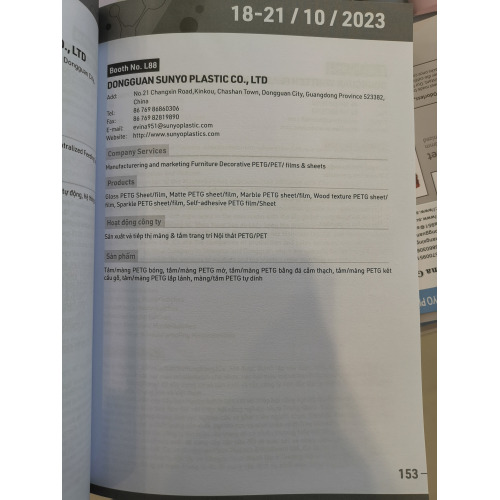[China Packaging Network News] China's polyester industry has developed rapidly, of which polyethylene terephthalate (PET) is widely used in the production of spelling, fiber, film and other products. PET film is widely used in food packaging because of its excellent physical and chemical properties. However, some of its monomers, catalysts, and other auxiliaries, including by-products, are highly toxic and pose a risk of migration.
With the advancement of petrochemical technology, China has made rapid progress in the polyester industry and has now become the world's largest polyester product production base. Among them, polyethylene terephthalate (PET) is widely used for producing bottles, fibers, and films because of its excellent rigidity, heat resistance, electrical insulation, and chemical resistance. PET film has a wide range of uses in electronic appliances, food packaging, and photosensitive materials. Common synthesis methods for PET include direct esterification of terephthalic acid (PTA) with ethylene glycol (EGA) and transesterification of dimethyl terephthalate (DMT) with ethylene glycol (DMT). law). In the polycondensation reaction of PET, it is necessary to add catalysts (such as antimony trioxide), stabilizers, and other additives or auxiliaries, and accompanying by-products such as diethylene glycol, acetaldehyde, and some oligomers during the esterification reaction. ) Produce, and some of these substances are toxic, and in the process of contact with food will migrate to the contents through packaging materials, resulting in contamination of the contents, further affecting the health of consumers. Dong-Joo Kim et al. studied and analyzed the special migration of monomers and oligomers in PET according to EU and Asian national regulations. Countries around the world (the European Union, the United States, China, Japan, etc.) have formulated corresponding regulations for the health and safety requirements of PET for food packaging materials, and have set limits on the maximum migration limit and use requirements for substances with migration risks.
PET synthesis process and raw materials used
PET is often used in the following two synthesis methods: direct esterification of terephthalic acid (PTA) with ethylene glycol (EGA) and transesterification of dimethyl terephthalate (DMT) with ethylene glycol. Method (DMT method). Direct esterification is the direct esterification of PTA and EG to an oligomer of terephthalic acid and ethylene glycol (bisHydroxyethyl Terephthalate BHET), followed by polycondensation. The transesterification method converts terephthalate esters into dimethyl terephthalate, and then refines and then transesterifies to synthesize polyester. Compared with the transesterification method, the direct esterification method has the advantages of short process, low consumption, and safe production. The direct esterification process has been the main production process and preferred technology route for polyester since the 1980s.
The main raw materials for synthetic PET are: terephthalic acid (TPA), dimethyl terephthalate (DMT), ethylene glycol (EG). The catalysts are mainly metal compounds such as lanthanide-based catalysts, lanthanide-based catalysts, and titanium-based catalysts. Among them, ruthenium-based catalysts have the advantages of high activity, low side reactions, low degree of promotion of thermal degradation reaction of polyesters, low price, and high quality of manufactured products, so they are most widely used. Commonly used ruthenium-based catalysts are ethylene glycol hydrazine, cesium acetate and antimony trioxide. However, the toxicity of antimony compounds will adversely affect human health and the environment. In recent years, new requirements have been put forward for the use of antimony in countries around the world. For example, the European Union requires that less than 0.01 mg/kg of nicotine per kilogram of packaging materials transferred to food. .
BOPET film production process

There are three main methods for processing PET films: casting (APET), blow molding, and planar biaxial stretching (BOPET). Each of the three methods has its own advantages and disadvantages, and the properties of the resulting films are also different. Among them, the planar biaxially oriented polyester film (BOPET) is the most excellent in quality and the most widely used. BOPET production equipment includes DMT from France, Bruckner from Germany, Dornier from Germany and Mitsubishi Heavy Industries from Japan.
Toxicology of PET raw materials
The raw materials involved in PET synthesis, such as terephthalic acid, ethylene glycol, and lanthanide catalysts, have a certain impact on human health. The specific hazards are described below.
Terephthalic acid: White, relatively loose crystalline powder at room temperature, non-toxic, flammable. Has irritating effects on eyes, mucous membranes and upper respiratory tract.
Ethylene Glycol: It is a low-toxic substance that can cause acute poisoning if it is inhaled by vapors of ethylene glycol that has been heated and vaporized or is misused. If it is inhaled for a long period of time, it will be chronically poisoned. Rat LD50 was 5.5 to 8.54 mL/kg, and once oral LD50 was 80 to 100 g. The blood glycol concentration of 2.4g/L can cause acute renal failure. Inhalation poisoning manifests as confusion, nystagmus, urine protein, calcium oxalate crystals and red blood cells.
Lanthanide series catalysts: Lanthanide series catalysts are the most commonly used catalysts in the production of polyesters. They are mainly antimony trioxide, antimony acetate, and ethylene glycol germanium, all of which are white crystalline powders. Deuterium acetate and ethylene glycol decompose into acetic acid and thorium oxide fumes when heated, and yttrium oxide fumes are highly toxic, causing gastrointestinal disorders, vomiting, diarrhea, and neurological diseases.
Introduction of relevant laws and regulations for PET hygiene safety requirements for food contact
PET film has been widely used in food packaging because of its excellent physical and chemical properties such as high strength, good transparency, non-toxicity, good barrier properties, and excellent electrical insulation properties. However, some of its monomers, catalysts, and other auxiliaries, including by-products, are highly toxic and pose a risk of migration. Countries around the world have set corresponding standards for PET hygiene requirements for food contact.
1. European Union (EU) NO 10/2011 Plastic materials and articles on anticipated food contact
The regulatory requirements for the specific migration of monomers and additives in PET, including its by-products, are shown in Table 1.

As can be seen from Table 1, the special migration of monomers and additives and by-products in PET is limited in (EU) No. 10/2011. Among them, quinone belongs to highly toxic metals (acute toxicity: peritoneal-rat LD50: 100 mg/kg; peritoneal-mice LD50: 80 mL/kg). The toxicity of guanidine depends on its chemical structure and oxidation state, and the trivalent quinone is more expensive than pentavalent guanidine. More toxic.
The specific migration test for earthworms in EU regulations uses the following simulated liquids: 3% acetic acid (B), 20% ethanol (C), and olive oil (D2). For foods that are hydrophilic and capable of extracting hydrophilic substances, food simulants A, B, and C are used; foods with a pH less than 4.5 use simulant B; alcohol-containing foods that do not exceed 20% alcohol content and those that contain certain The amount of organic components and the more hydrophilic foods used Mimic C; the foods containing free fat on the surface used mimic D2. Samples and simulant contact times and temperatures were selected for the worst conditions of use. The specific migration of niobium can be analyzed using ICP-MS, HG-AFS, and HPLC-ICP-MS.
2.FDA 177.1630 PET resin
This standard stipulates that the polyethylene terephthalate polymer can be safely used as a food contact plastic (film, various products) or plastic composition requirements.

Quality Index: Test the content of soluble extracts of PET in chloroform. Commonly used simulants are distilled water, n-heptane and 8% ethanol. The test conditions are 49°C×24hrs. The chloroform soluble extracts obtained should not exceed 0.05mg/in2. .
3.GB 9685-2008 Hygiene Standards for Use of Additives for Food Containers and Packaging Materials and Their Exposure Drafts
The requirements of GB 9685-2008 for the specific migration of monomers and additives in PET, including its by-products, are shown in Table 2.

From Table 2, it can be seen that GB 9685-2008 also has specific limit values for the special migration of monomers, additives, and by-products in PET, among which the most stringent requirements are for helium.
The GB 9685 consultation draft issued in 2015 compared with the 2008 edition of 338 additive species and adjusted the structure of the additive appendix. The list of additives and their use requirements are classified according to the scope of use. The special migration limits for monomers, additives, and their by-products in PET are listed in the table above. At the same time, the specific total migration limit for acetaldehyde by-product SML(T) was increased by 6 mg/kg (acetaldehyde).
4.GB 13113-1991 Sanitary Standards for PET Products Used in Food Containers and Packaging Materials
This standard applies to containers, films and composites made from polyethylene terephthalate resin for food packaging. The health standards for PET are shown in Table 3.
5.GB XXXX-XXXX Food Contact Plastic Materials and Products (Draft for Comment)
The draft for the release of food contact plastic materials and products issued in 2015 is a standard for all food contact plastic materials and products, including PET, which will replace GB 13113-1991 PET for food containers and packaging materials. Product hygiene standards, physical and chemical indicators specific requirements such as the table
The regulations also stipulate that additives used in plastic materials and products should meet the requirements of GB 9685.
6. Japanese food and food additive hygiene standards
The health standard requirements for PET resin in this standard include the following:
The health and safety requirements for PET in the above countries have their own emphasis. However, through these standards, it can be seen that the special migration of monomers, additives, auxiliaries including by-products and evaporation residues in PET for food contact are the focus of product safety concerns.
The commonly used synthesis methods of polyethylene terephthalate (PET) include direct esterification (PTA) and transesterification (DMT), which are widely used in food because of their excellent physical and chemical properties. Packaging area. However, additives and auxiliaries such as catalysts and stabilizers used in the polycondensation reaction of PET, including by-products from the reaction, have attracted widespread attention due to their toxicity and the risk of migration. The EU, the United States, China, Japan and other countries have formulated corresponding regulations for the health and safety requirements of PET for food packaging materials, which effectively regulates the development of PET towards a healthier and safer direction.
(Source: Food Safety Guide)




